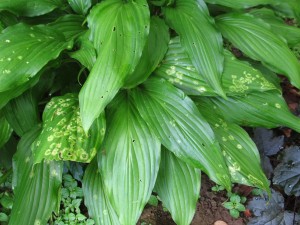There are nearly 1,000 fungal pathogens that cause leaf spot diseases on garden plants. Fungal leaf spots vary in size—from the size of a pinpoint to lesions that consume the entire leaf. Many leaf spots are tan to dark brown in color and may be circular, angular or irregular in shape.
Some of the common leaf spot-causing fungi are Alternaria, Ascochyta, Cercospora, Colletotrichum, Fusarium, Gloeosporium, Helminthosporium, Phyllosticta, Ramularia and Septoria. Generally, they do not kill plants but mar their attractiveness.
Most leaf spot diseases require cool conditions, wet foliage, high humidity and little air movement. Crowded plants often lead to leaf spot infections. Long intervals of wet weather in spring and summer or overirrigating enhances infection outbreaks.
The first rule is to keep foliage as dry as possible. Water at times of the day when the foliage will quickly dry out; avoid late night irrigation. Secondly, increase air movement around plants.
Learn to properly identify leaf spots by the symptoms and adopt the best control strategies. Leaf samples may be sent to a diagnostic clinic at your state’s university lab or local Extension office.
A number of fungicides are labeled for controlling a wide range of leaf spot diseases. Some of the most effective for leaf spots include Pageant (pyraclostrobin + boscalid), Medallion (fludioxonil), Eagle/Systhane (myclobutanil), Chipco 26 GT (iprodione) and Daconil (chlorothalonil).
Remember that fungicides are protectants and not cure-alls. Applied the fungicide before symptoms (leaf spotting) is detected. These products can prevent fungal leaf spots from spreading. Good cultural practices and irrigation timing, along with proper preventative or control strategies will greatly reduce leaf spot severity.
Credit: Thank you to Paul Pilon, Ball Horticulture, Chicago for information in this blog.


 Posted in
Posted in 
